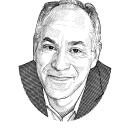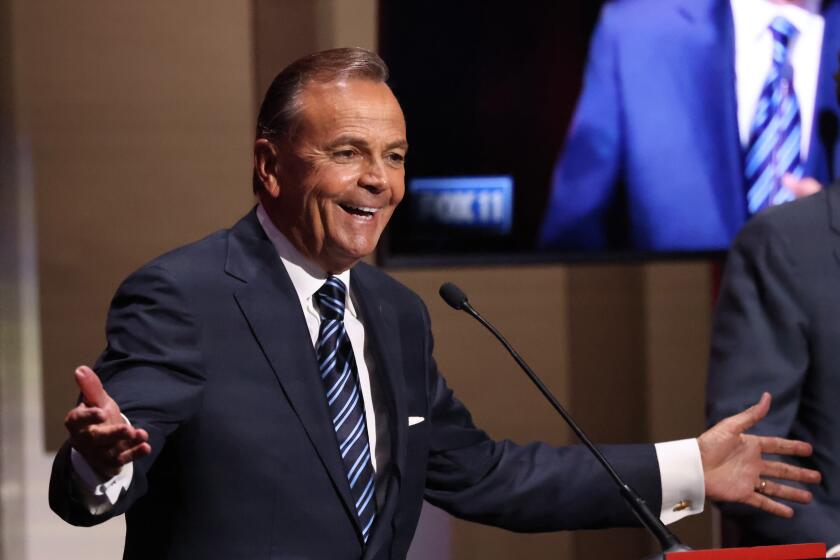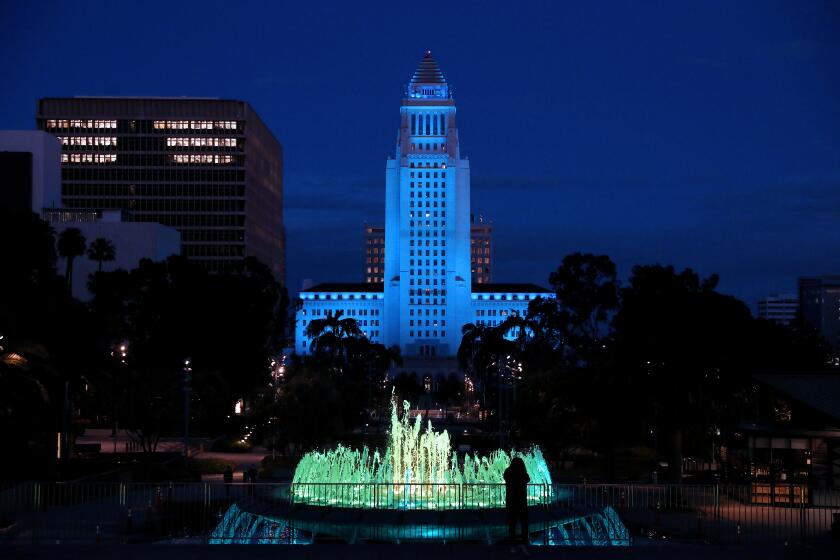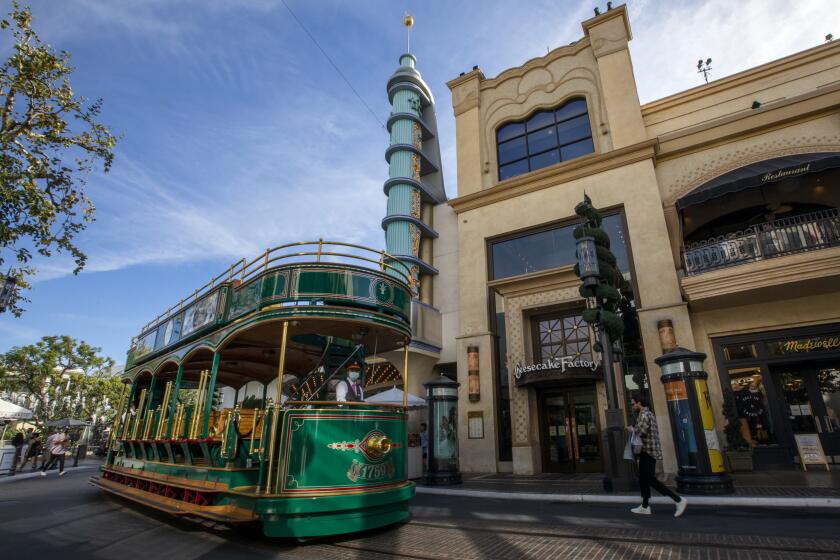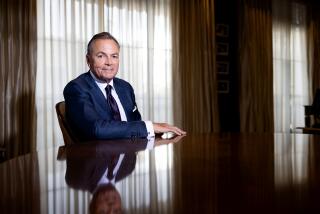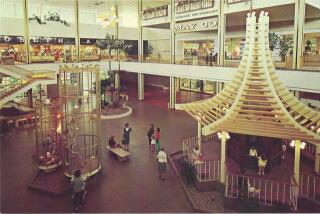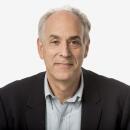Column: If Rick Caruso becomes mayor, will Los Angeles be all dancing fountains and trolley rides?
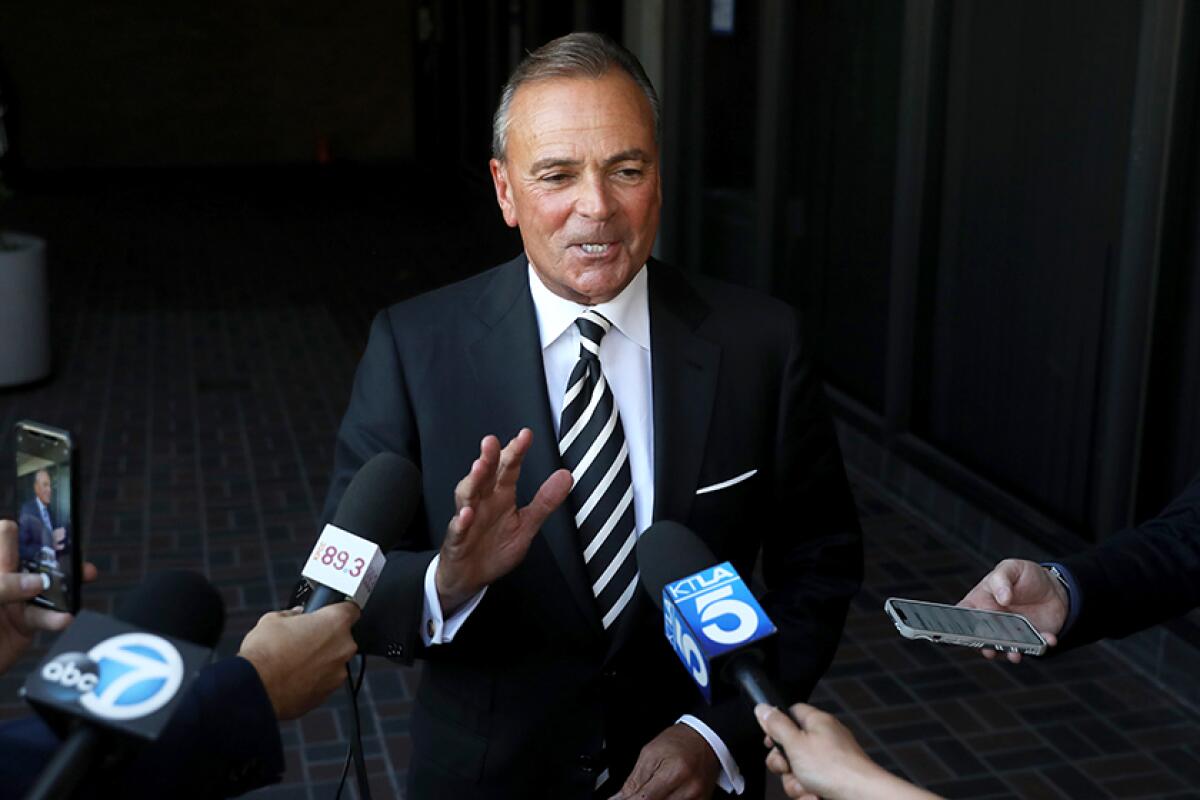
- Share via
You don’t see poor people at the Grove. Homeless people don’t pitch tents by the fountain. The ground is litter-free, the shoppers seem generally cheerful, affluent and eager to buy and spend. Families lounge on the grass, their shopping bags nearby.
Frank Sinatra music wafts through the air and the trolley never stops running. It even snows fake snow at Christmastime.
I initially worried that it might be unfair to write about Rick Caruso’s candidacy for mayor through the prism of the urban fantasyland he’s created at the Grove. But on reflection, it is impossible not to. The Grove is what he’s built, it’s his legacy and, at least on some level, it’s what he’s selling in his campaign.
Opinion Columnist
Nicholas Goldberg
Nicholas Goldberg served 11 years as editor of the editorial page and is a former editor of the Op-Ed page and Sunday Opinion section.
Sure, he’s also the “grandson of immigrants,” as his ads tell us. He led the L.A. Police Commission. He served on the Los Angeles Department of Water and Power board. But the Grove — along with the other outdoor mall properties he’s built in the region, including the Americana at Brand in Glendale and Palisades Village in Pacific Palisades — is what defines Caruso to most Angelenos.
He’s never made a secret of the fact that the Grove was his squeaky-clean vision of what a city could — or at least should — be.
“I wanted to create a Main Street,” he said, “for a city that does not have one.”
He said he hoped it would “transport people to a better place and time.” A place, he once said, where “you’re not going to have crime, you’re not going to have graffiti.”
And that’s what he built: a facsimile of urban life stripped of the unpleasant parts.
Column: Only Karen Bass knew Rule No. 1 in the mayoral debate: Don’t help Rick Caruso steal the show
Most candidates seemed determined to cut latecomer Rick Caruso down to size, but they wound up making him the star of this TV production.
Now, 20 years after the Grove opened, Caruso has emerged from behind the big walls along 3rd Street saying he wants to run the rest of the city as well. And what’s his plan? To do away with crime, corruption and homelessness and clean up the streets — just like he did in his idealized playland.
I’m oversimplifying, of course. Caruso would never be foolish enough to suggest that he was actually going to transform a sprawling, complicated, troubled city like L.A. into a land of dancing fountains, trolley rides, faux snow and wafting crooner music. No one would believe such an outlandish promise.
But in some very subtle or even subliminal way, surely that’s his pitch.
In his campaign, Caruso makes the connection pretty explicitly, describing himself as the creator of “the Southland’s most beloved community centers.”
And that’s a characterization that’s hard to argue with. The Grove alone hosted 20 million visitors a year pre-pandemic, more than the Great Wall of China, according to one profile, and more than Disneyland.
The Americana at Brand, the new mega-project by mega-developer Rick Caruso, was set to open two days ago.
People stay about three hours on average, rather than 90 minutes as they do at most malls, according to the company. More than 90% of visitors to the Grove make a purchase. The hokey green trolley that runs 1,600 feet through the complex carries more people per mile than any railroad in the state of California, says Caruso.
Caruso’s shopping mall vision is working out well for him. Forbes estimates he is worth $4.3 billion.
I went to the Grove recently — my first visit since the pandemic began — and, as usual, even though I wanted to hate it, I did not.
I hate the idea of it. I hate its inauthenticity, its childish theme park mentality, its faux Italian architecture. But I can’t deny that everyone I saw was having fun. Kids chased bubbles on a lawn I thought was astroturf. (It wasn’t; I ripped some blades out to be sure.) “I’ve Got the World on a String” was playing. My lunch, including a “Caruso salad,” was delicious.
But I kept having to remind myself: It’s all a big fantasy. And that’s what voters should remember too.
Unreality has always been the Grove’s chief product for sale. Part movie set, part theme park, it was built with the help of film production designers and former Disney “imagineers.” It’s a knock-off. It’s a facade.
The leading candidates have barely discussed how they would tackle the climate crisis. So we asked them.
It’s not the real world and it doesn’t play by real-world rules. Don’t be taken in!
As many have noted before me, the Grove is private space masquerading as public space. A tightly run business masquerading as a civic downtown. It’s patrolled by its own private security force. No homeless person would be allowed to pitch a tent here.
The critics have been generally scathing. It’s a “protected, sanitized development,” wrote former Times architecture critic Christopher Hawthorne. He called it Caruso’s “particularly successful brand of faux urbanism.”
In his book “Sidewalking,” L.A. author and critic David Ulin wrote that it offers “the illusion of naturalness, the idea that what it presents is a taste of something that resembles city life.”
Norman Klein, a professor at the California Institute of the Arts, called the Grove a “consumerist fantasy,” a classic example of a “scripted space.”
In the mayoral race, Rick Caruso’s message is everywhere: He can fix L.A. Except that running the city is not like running the Grove.
As many have noted, the Grove puts up walls to the outside world. It doesn’t engage with Los Angeles because so few of its buildings open directly onto the city streets. It faces inward; it’s separate and apart.
None of this means that Caruso couldn’t be a competent mayor or that he doesn’t have the best intentions for the city, although I didn’t find much to love in his recent endorsement interview with The Times. (I also object to a billionaire jumping late into the race and buying support by drastically outspending his rivals.)
My point is this: To the extent that there’s a subliminal message that if you elect Caruso, you’ll get the Grove, be skeptical.
It ain’t gonna happen. And you wouldn’t want it to.
The Grove is fine for three hours, including a Caruso salad. But it’s not Los Angeles.
More to Read
A cure for the common opinion
Get thought-provoking perspectives with our weekly newsletter.
You may occasionally receive promotional content from the Los Angeles Times.
